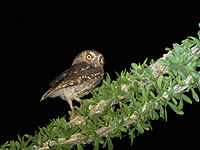Elf Owl
 From Conservapedia
From Conservapedia | Elf Owl | |
|---|---|

| |
| Scientific classification | |
| Kingdom Information | |
| Domain | Eukaryota |
| Kingdom | Animalia |
| Subkingdom | Bilateria |
| Branch | Deuterostomia |
| Phylum Information | |
| Phylum | Chordata |
| Sub-phylum | Vertebrata |
| Infraphylum | Gnathostomata |
| Class Information | |
| Superclass | Tetrapoda |
| Class | Aves |
| Sub-class | Neornithes |
| Infra-class | Neoaves |
| Order Information | |
| Order | Strigiformes |
| Family Information | |
| Families | Strigidae |
| Sub-family | Striginae |
| Genus Information | |
| Genus | Micrathene |
| Species Information | |
| Species | M. whitneyi |
| Population statistics | |
| Conservation status | Least concern[1] |
The elf owl (Micrathene whitneyi) is a species of owl found in the desert areas of North America.
Contents
- 1 Description
- 1.1 Subspecies
- 2 Range
- 3 Breeding
- 4 Threats
- 5 References
Description[edit]
The elf owl is the world’s smallest owl, with a length of 5.75 inches, a wingspan of 13 inches, and a body weight of 1.4 ounces. Plummage is a greyish-brown, with mottled vertical barring on a light-colored underside. They have no ear tufts, and the yellow eyes are accentuated by whitish "eyebrows".
Their size limits the birds to feed chiefly on insects - sometimes in flight, but more often by foraging among the desert flowers and plants. Very rarely will elf owls take small lizards and rodents, and only if they are weak. They have excellent eyesight in low light levels, but rely on their hearing to catch their prey; like many owls, they can accurately catch prey by hearing alone.
Subspecies[edit]
- Socorro elf owl, Micrathene whitneyi graysoni
- Texas elf owl, Micrathene whitneyi idonea
- Sanford's elf owl, Micrathene whitneyi sanfordi
- Whitney's elf owl, Micrathene whitneyi whitneyi
Range[edit]
Elf owls have a breeding range in the southwestern United States, from California to southern Texas; these birds migrate during the winter months to the western slopes of the Sierra Madre mountains. Year-round they are found in the Mexican states of Baja California Sur, southern Sonora, and northern Sinaloa.
Subspecies M. w. sanfordi is restricted to the southern end of Baja California, and does not migrate. Subspecies M. w. graysoni was found only on the island of Socorro, some 600 miles west of the Mexican mainland. Not seen alive since the early-1930s, this owl is believed to have been extinct since 1970.[2]
Breeding[edit]
Elf owls begin breeding by March, nesting in tree cavities or holes in saguaro cactus, both created and abandoned by woodpeckers. Up to four white eggs are laid, with an incubation period of three weeks, with both parents raising the chicks. Fledging takes place a month after hatching.
Threats[edit]
Elf owls are listed as least concern on the IUCN Red Data List, due primarily to their extensive range in desert habitats; however, numbers are decreasing in the southwestern United States due to human conversion of desert areas for farming and suburban development.
Natural predators include other owls, coyotes, ringtail cats, bobcats and some snakes.
References[edit]
- ↑ http://www.iucnredlist.org/details/22689325/0
- ↑ http://beautyofbirds.com/elfowls.html
Categories: [Birds] [Birds of Prey] [Owls]
↧ Download as ZWI file | Last modified: 02/28/2023 02:21:46 | 8 views
☰ Source: https://www.conservapedia.com/Elf_owl | License: CC BY-SA 3.0
 ZWI signed:
ZWI signed: KSF
KSF